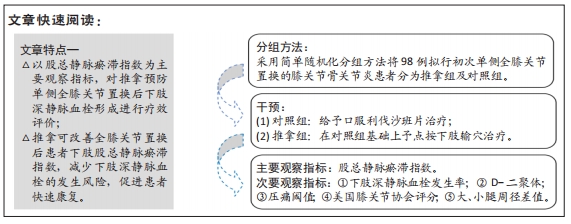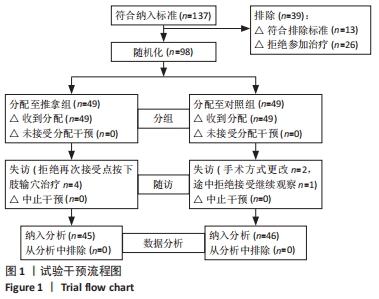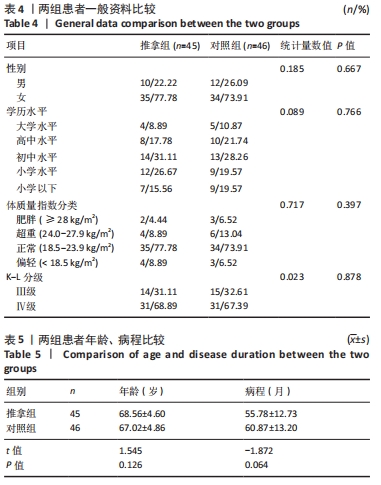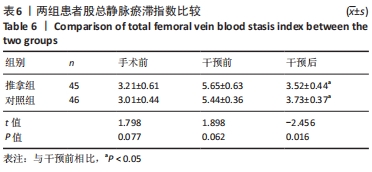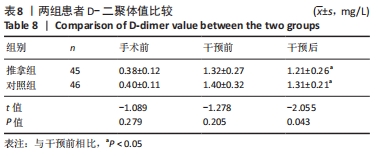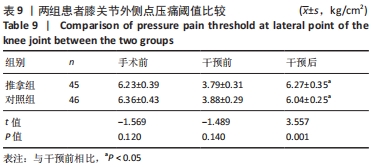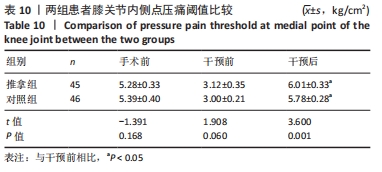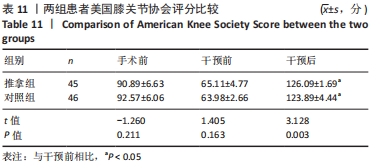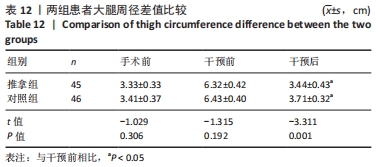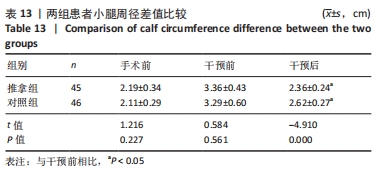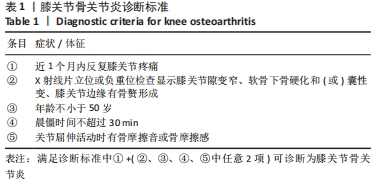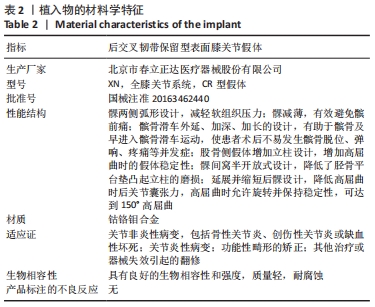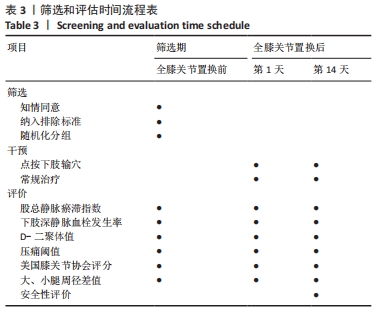[1] GENÊT F, SCHNITZLER A, LAPEYRE E, et al. Change of impairment, disability and patient satisfaction after total knee arthroplasty in secondary care practice. Ann Readapt Med Phys. 2008;51(8):671-676,676-682.
[2] KANG KS, TIEN TN, LEE MC, et al. Suitability of Metal Block Augmentation for Large Uncontained Bone Defect in Revision Total Knee Arthroplasty (TKA). J Clin Med. 2019;8(3):384.
[3] SKOU ST, ROOS EM, LAURSEN MB, et al. A Randomized, Controlled Trial of Total Knee Replacement. N Engl J Med. 2015;373(17):1597-1606.
[4] 中华医学会骨科学分会. 中国骨科大手术静脉血栓栓塞症预防指南[J].中华骨科杂志,2016,36(2):65-71.
[5] WIZNIA DH, SWAMI N, NGUYEN J, et al. Patient compliance with deep vein thrombosis prophylaxis after total hip and total knee arthroplasty. Hematol Rep. 2019;11(2):7914.
[6] COTE MP, CHEN A, JIANG Y, et al. Persistent Pulmonary Embolism Rates Following Total Knee Arthroplasty Even With Prophylactic Anticoagulants. J Arthroplasty. 2017;32(12):3833-3839.
[7] CALABRO L, CLEMENT ND, MACDONALD D,et al. Venous thromboembolism after total knee arthroplasty is associated with a worse functional outcome at one year. Bone Joint J. 2021;103-B(7):1254-1260.
[8] 张羽墨,鲁梦倩,于天源,等.推拿按摩在血栓性疾病中的应用概况[J].时珍国医国药,2020,31(9):2221-2223.
[9] 张羽墨,鲁梦倩,于天源,等.推拿五法对深静脉血栓模型大鼠凝血、纤溶功能的影响[J].北京中医药大学学报,2021,44(5): 462-467.
[10] 庞军,胡庆,唐宏亮,等.枢经推拿法对脑梗塞患者脑血流动力学影响的临床研究[J].辽宁中医杂志,2017,44(1):132-134.
[11] 辛丽,甘秀妮,娄兰兰.穴位按摩预防妇科腹腔镜术后深静脉血栓发生的影响[J].中国中西医结合杂志,2016,36(8):942-945.
[12] 王静华,刘武岩,谢博多,等.推拿配合持续冰敷对全膝关节置换术后康复及预防下肢深静脉血栓形成的效果[J].世界中医药,2017, 12(6):1432-1435.
[13] 刘莉婷.中药足浴结合小腿推拿对髋关节置换患者下肢深静脉血栓形成的影响[J].血栓与止血学,2018,24(6):950-951,956.
[14] 吴志远,贾杰,欧阳桂林,等.推拿手法对全膝关节置换术后患者康复及D-二聚体水平的影响[J].成都医学院学报,2012,7(4):536-539.
[15] 中华医学会骨科学分会关节外科学组.骨关节炎诊疗指南(2018年版)[J].中华骨科杂志,2018,38(12):705-715.
[16] 甘玲,刘山俊,肖夏,等.静脉瘀滞指数评估妇科恶性肿瘤切除术后下肢深静脉血栓发生风险[J].医学影像学杂志,2019,29(6):1031-1034.
[17] 邹林汝,谭开彬,高云华,等.静脉瘀滞指数对关节置换术后下肢深静脉血栓风险的评估[J].中国超声医学杂志,2015,31(11):1032-1034.
[18] 侯玉芬,刘政.下肢深静脉血栓形成诊断及疗效标准(2015年修订稿)[J].中国中西医结合外科杂志,2016,22(5):520-521.
[19] 刘永裕,徐景利,林天烨,等.D-二聚体诊断髋关节置换后慢性假体周围感染的敏感性和特异性[J].中国组织工程研究,2021,25(12): 1853-1857.
[20] 徐道志,张晓辉,林松,等.复元活血汤对老年腰椎管狭窄症患者术后凝血功能及下肢深静脉血栓形成的影响[J].中国中医急症, 2021,30(2): 241-243.
[21] 杨良枫,黄金友,黄进成,等.全髋关节置换术后冰敷方案的选择及其对深静脉血栓形成的影响[J].护理研究,2021,35(1):146-150..
[22] LeUNG YY, LIM Z, FAN Q, et al. Pre-operative pressure pain thresholds do not meaningfully explain satisfaction or improvement in pain after knee replacement: a cohort study. Osteoarthritis Cartilage. 2019;27(1): 49-58.
[23] REYNAUD V, VERDILOS A, PEREIRA B, et al. Core Outcome Measurement Instruments for Clinical Trials of Total Knee Arthroplasty: A Systematic Review. J Clin Med. 2020;9(8):2439.
[24] BRIONES-CANTERO M, FERNÁNDEZ-DE-LAS-PEÑAS C, LLUCH-GIRBÉS E, et al. Effects of Adding Motor Imagery to Early Physical Therapy in Patients with Knee Osteoarthritis who Had Received Total Knee Arthroplasty: A Randomized Clinical Trial. Pain Med. 2020;21(12):3548-3555.
[25] GUÉRARD O, DUFORT S, FORGET BESNARD L, et al. Comparing the association of widespread pain, multi-joint pain and low back pain with measures of pain sensitization and function in people with knee osteoarthritis. Clin Rheumatol. 2020;39(3):873-879.
[26] HANSEN S, VAEGTER HB, PETERSEN KK. Pretreatment Exercise-induced Hypoalgesia is Associated With Change in Pain and Function After Standardized Exercise Therapy in Painful Knee Osteoarthritis. Clin J Pain. 2020;36(1):16-24.
[27] REDDY KI, JOHNSTON LR, WANG W, et al. Does the Oxford Knee Score complement, concur, or contradict the American Knee Society Score? J Arthroplasty. 2011;26(5):714-720.
[28] INSALL JN, DORR LD, SCOTT RD, et al. Rationale of the Knee Society clinical rating system. Clin Orthop Relat Res. 1989;(248):13-14.
[29] 刘振斌,王刚,李梦虎.下肢深静脉血栓形成的中西医治疗进展[J].中国中西医结合外科杂志,2021,27(1):149-153.
[30] 孙亚萌,张建政,刘智.老年骨折患者下肢深静脉血栓形成的危险因素及动态D-二聚体对其预测价值的分析[J].中国骨与关节杂志, 2020,9(6):419-424.
[31] 霍景山,黄子健,贺友.补阳还五汤合四妙散治疗急性左下肢周围型下肢深静脉血栓的效果及对D-二聚体和超敏C-反应蛋白的影响[J].中国医药导报,2019,16(15):128-131.
[32] 李朋,廖荣臻,罗天,等.益气活血通脉方预防膝关节置换术后深静脉血栓的临床研究[J].中药新药与临床药理,2021,32(2):268-273.
[33] 侯军杰,王卫刚,谭国昭.舒筋活血汤联合中医推拿对人工全膝关节置换术后患者康复的影响[J].河北中医,2018,40(6):847-851.
[34] 黄盈,苏红侠,李春梅,等.中脘穴点按对泌尿外科腹腔镜术后胃肠功能紊乱的治疗效果[J].中国内镜杂志,2020,26(7):47-51.
[35] 孙琰,陈学玲,杨六中,等.中药穴位贴敷联合循经点按预防骨折术后深静脉血栓40例临床研究[J].江苏中医药,2018,50(6):59-61.
[36] 刘颖,张学丽,杜琳,等.针刺输穴、经穴治疗中风患肢水肿疗效观察[J].中国中医药信息杂志,2009,16(S1):54-55.
[37] 陈思宇,金末淑,徐彬,等.五输穴现代研究概况[J].中国中医药信息杂志,2008,15(9):100-103.
[38] 熊大昌.太白穴在临床中的应用[J].中国中医药信息杂志,2009,16(6): 87-88.
[39] 安琪,张帆,周佳华,等.针刺陷谷穴脑功能磁共振成像研究[J].中医药学报,2016,44(5):58-60.
[40] 刘康,田丽芳.针刺内关、太冲穴治疗膝骨性关节炎[J].中国针灸, 2013,33(2):105-108.
[41] 高丽美,任玉兰,郭太品,等.太冲穴及常见配伍运用规律的文献研究[J].时珍国医国药,2013,24(6):1531-1532.
[42] 申伟,汤继芹,张永臣,等.浅析《针灸大成》中足临泣穴的临床应用[J].湖南中医杂志,2015,31(1):93-94.
[43] 谷深,陈旭,张祖善.针刺配合肌内效贴治疗脑卒中后下肢水肿[J].中国老年保健医学,2016,14(5):79-80.
[44] 杨望,罗红燕,吴小平,等.《针灸大成》太溪穴临床应用规律探析[J].中国医学创新,2020,17(35):147-151.
|
